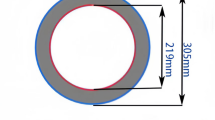Abstract
The blast damage behavior of reinforcing bars embedded in a High Strength Concrete (HSC) exposed to blast loading is investigated. In order to properly evaluate the HSC slab subject to blast loading, an explicit analysis program was used in this work. The multi-physics method of coupled Eulerian-Lagrangian solver is used to improve the efficiency and reliability of numerical simulation. To enhance the accuracy of the simulation results, the equation of state, strength and failure models of materials are implemented in AUTODYN. Specifically, the implemented multi-limit strength and failure surface models included strain rate effect and tensile fracture energy for HSC. The realized and idealized 3D quarter-symmetric models are used to obtain a reasonable computational running time, and the numerical simulation of the spalling and scabbing of an HSC slab under blast loading is presented. To validate the implemented material models and analysis method, a comparison is made with reported experimental results, and the simulation results are found to be in good agreement with the experimental results.
Similar content being viewed by others
References
Autodyn Theory Manual Revision 4.3 (2005). Concord (CA, USA): Century Dynamics Inc.
BaŽant, Z. P. and Oh, B. (1983). “Crack band theory for fracture of concrete.” Materials and Structures, Vol. 16, No. 3, pp. 155–177.
Birnbaum, N. K., Francis, N. J., and Gerber, B. I. (2004). “Coupled techniques for the simulation of fluid-structure and impact problems.” 5th Asia-Pacific Conference on Shock and Impact Load on Structures, China.
CEB Comité Euro-International du Béton (1993). CEB-FIP model code 1990, Trowbridge, Wiltshire, UK: Redwood Books.
Hanssen, A. G., Enstock, L., and Langseth, M. (2002). “Close-range blast loading of aluminum foam panel.” International Journal of Impact Engineering, Vol. 27, No. 6, pp. 593–618.
Herrmann, W. (2009). “Constitutive equation for the dynamic compaction of ductile porous materials.” Journal of Applied Physics, Vol. 40, No. 6, pp. 2490–2499.
Johnson, G. R. and Cook, W. H. (1983). “A Constitutive modeling and data for metals subjected to large strain-rates and high temperatures.” Proceedings of 7th International Symposium on Ballistics, pp. 541–577.
Landis, E. N. and Shah, S. P. (1995). “The influence of microcracking on the mechanical behavior of cement based materials.” Advanced Cement Based Materials, Vol. 2, No. 3, pp. 105–118.
Leppänen, J. (2004). Concrete structures subjected to fragment impacts, PhD Thesis, Department of Structural Engineering Concrete Structures, Chalmers University of Technology, Goteborg, Sweden.
Li, V. C. and Maalej, M. (1996). “Toughening in cement based composites. Part I: Cement, mortar, and concrete.” Cement and Concrete Composites, Vol. 18, No. 4, pp. 223–237.
Liu, G. R. and Liu, M. B. (2005). Smoothed particle hydrodynamics-A meshfree particle method, WorldScientific.
Lu, Y. and Z. Wang. (2006). “Characterization of structural effects from above-ground explosion using coupled numerical simulation.” Computers & Structures, Vol. 84, No. 28, pp. 729–1742.
Malvar, L. J. and Ross, C. A. (1998). “Review of strain rate effects for concrete in tension.” ACI Materials Journal, Vol. 95, No. 6.
Nam, J. W., Kim, J. H. J., Kim, S. B., Yi, N. H., and Byun, K. J. (2008). “A study on mesh size dependency of finite element blast structural analysis induced by non-uniform pressure distribution from high explosive blast wave.” KSCE Journal of Civil Engineering, Vol. 12, No. 4, pp. 259–265.
Riedel, W., Thoma, K., and Hiermaier S. (1999). “Numerical analysis using a new macroscopic concrete model for hydrocodes.” Proceedings of 9th International Symposium on Interaction of the Effects of Munitions with Structures, pp. 315–322.
Tanaka, H. and Tsuji, M. (2003). “Effects of reinforcing on damage of reinforced concrete slabs subjected to explosive loading.” Concrete Research and Technology, Vol. 14, No. 1, pp. 1–11.
Tham, C. (2009). “Numerical simulation on the interaction of blast waves with a series of aluminum cylinders at near-field.” International Journal of Impact Engineering, Vol. 36, No. 1, pp. 122–131.
Wu, K.-C., Li, B., and Tsai, K.-C. (2011). “Residual axial compression capacity of localized blast-damaged RC columns.” International Journal of Impact Engineering, Vol. 38, No. 1, pp. 29–40.
Zineddin, M. Z. (2002). Behavior of structural concrete slabs under localized impact, PhD Thesis, Department of Civil and Environmental Engineering, The Graduate School, The Pennsylvania State University, pp. 58–65.
Author information
Authors and Affiliations
Corresponding author
Rights and permissions
About this article
Cite this article
Yun, SH., Park, T. Multi-physics blast analysis of reinforced high strength concrete. KSCE J Civ Eng 17, 777–788 (2013). https://doi.org/10.1007/s12205-013-0093-7
Received:
Revised:
Accepted:
Published:
Issue Date:
DOI: https://doi.org/10.1007/s12205-013-0093-7




